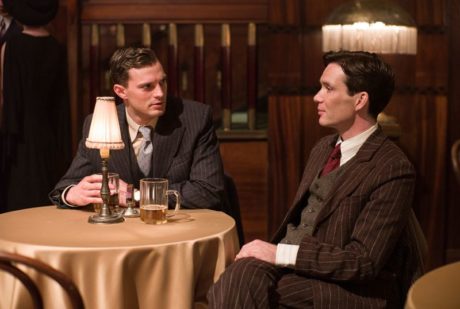Operation Anthropoid was the code name for a mission planned by Czech government-in-exile with the British SOE to assassinate Reinhard Heydrich, who was the head of the SS and a primary logistical architect of the Final Solution, that whole plan to rid the world of Jews, while he was in charge of oppressing Czechoslovakia after it had been annexed by Nazi Germany.

Anthropoid, the film, acts as though the World War II era was so rich with brutal, world class oppressors, it’s possible to be unfamiliar with a weapons-grade racist murderer like Heydrich. That might even be true, but it leaves the film with a lot of heavy narrative lifting. The film has to explain Heydrich and the state of the Czech resistance and explore the personal experiences of Josef Gabcík, played with steely intensity by Cillian Murphy, and Jan Kubis, played by Irish hunk who can’t quite ditch his native accent Jamie Dornan.
Trying to cram that much history into a story that is already crammed with plot takes the thrill out of this thriller, though Ellis excels early on at making tension palpable, as death and betrayal hang in the air as Jan and Josef attempt to make contact with what is left of the Czech resistance. That tension becomes far less palpable when the film establishes the emotional entanglements that Kubis and Gabcík, stumble into, despite constant warnings from Gabcík and all of the Czech Resistance fighters of the danger of doing so. Kubis still falls hard for Maria, played with youthful hope by Charlotte Le Bon, a local girl recruited as window dressing for their reconnaissance missions.
Maria draws in Lenka, an assured Anna Geislerová, every bit Murphy’s equal for intensity, and every bit the resistance fighter’s match for guile and subterfuge (still, sadly, window dressing). Gabcík falls for Lenka every bit as hard as Kubis does Maria, though he has the good sense to lock his emotions up during the mission.
Ellis needs to establish the personal stakes for our antagonists so we can feel the full weight of their eventual fates, which in real life almost invariably meant “And then the Germans killed everyone.” That is certainly the case for everyone who was part of Operation Anthropoid, but also anyone the Germans thought were vaguely connected to it, including the village of Lidice, which they tried to erase from the face of the Earth because of a rumor. The real life stakes were incredibly high.
Unfortunately, these emotional beats happen so quickly that we don’t have time to give these emotional connections as much weight as the characters do. But Anthropoid is a movie of two halves and Ellis turns a corner after the cack-handed but ultimately successful attempt to kill Heydrich. After the attack, which is well-filmed, tense, and attentive to detail, we are no longer just told about how awful the Nazis are, we get the full force of the Nazi secret police’s utter brutality. Thanks to a cowardly associate, the Germans quickly round up the family who hid Kubis and Gabcík and then we see them torture the teenage son into giving away the location of the entire team’s new hiding place, an Orthodox church. From this point on, Anthropoid is remarkably unflinching in following these doomed men to their fate at the hands of the Nazis.
Ellis gets more visually inventive when these men and women are being killed, creating striking, artfully abstracted visuals out of the experiences of pain and death in a way that feels radically different from the more matter of fact visual style earlier in the film. That’s only appropriate because Anthropoid stops being a spy thriller when the Germans find out where the team is located and they send the army into Ss. Cyril and Methodius Cathedral to capture them. As the reckoning comes for each of them, Ellis finds, or at least gestures at, some transfigurative visual element, appropriate to each moment, often slowing time down as each of them comes to terms with their imminent deaths.

While it is grinding to follow each character to their bitter ends (literally bitter in the case of those who took cyanide) as we repeatedly feel the hammer blows of the ferocity and the brutality of the Germans, Ellis creates several moments of cinematic grace, especially during the long, ferocious assault on the church, which in real life lasted for six hours. It does not take that long for the film, though it does occasionally feel like it might.
The World War II thriller film has died down as a source of inspiration for movies, probably a result of the combination of the passage of time and a sense that maybe enough of these stories have been told. Much of the work Ellis and company attempt in Anthropoid is overcoming a perceived historical gap in our moviegoing consciousness.
It’s a lot of information to cover, so its delivery feels perfunctory, functional and wholly inadequate. Despite the intensity of Dornan and Murphy, the first half of the film feels flat and affectless amid all the expositive table-setting. That said, by the end Ellis reminds us why stories from that era were so gripping. Ellis’ moments of visual grace also stand in stark contrast to some ugly realities and that feels like a small measure of justice for the people who died trying to make the world better.
Running Time: Two hours.
Anthropoid is playing at the E Street Cinema. Purchase tickets here.




